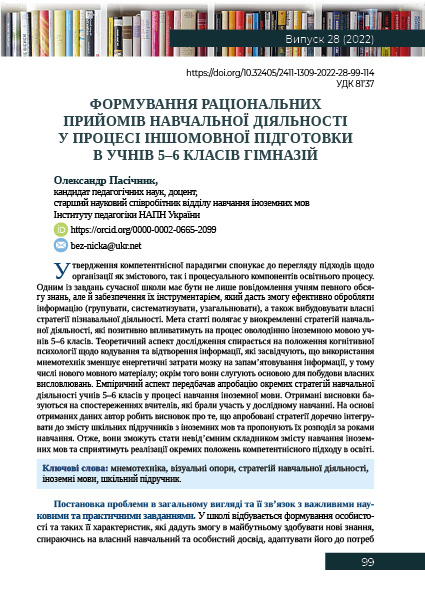Shaping Rational Strategies of Educational Activity to Boost Cognitive Skills of 5–6 Grade Students in the Process of Foreign Language Learning

Published 2022-07-20
Keywords
- mnemonics,
- visual aids,
- strategies of cognitive activity,
- foreign language acquisition,
- foreign language textbook
How to Cite

This work is licensed under a Creative Commons Attribution-NonCommercial-ShareAlike 4.0 International License.
Abstract
Introduction: Currently competence paradigm prompts educators to reconsider approaches to delivering content of education to students as well as provides them with tools to properly and adequately process the obtained didactic material, i. e. structure, systemize, and analyze it. Besides, students have to develop their own strategies of cognitive activity.
Research objective is to define educational strategies which will have a positive impact on the process of foreign language acquisition by students in grades 5–6.
Methodological background and research methods. Theoretical fundamentals of the research are based on findings of cognitive psychology which prove that mnemonic strategies simplify the process of memorizing new information, including linguistic material. Besides, these strategies enable students to express their own ideas in a more logical and structured way. The empirical aspect of the research was based on exposing 5–6-grade students to new strategies in the process of foreign language acquisition. The obtained results are based on teachers’ observations and feedback provided in the process of research.
Results. The following tasks of foreign language learning in grades 5–6 were considered of primary importance: the ability to work with vocabulary; the ability to express own ideas logically in written and oral forms; the ability to work with linear text. Empirical research proved that the following strategies have a positive impact on students’ cognitive processes: (1) umbrella method, (2) mind maps, (3) grouping data in tables, (4) visual cribs, (5) timeline, (6) 5Ws method.
Discussions and conclusions. Based on the obtained data the authors recommend to integrate the above-mentioned strategies in the content of foreign language textbooks so that students will be exposed to them in the process of language learning. The strategies are structured according to years of study. Although these strategies are considered vital for implementing principles of a competence-based approach in education, students are free to choose the most appropriate tools which correspond to their needs and learning styles.
Downloads
References
- Гусак, Л, Шапран, О, Шапран, Ю, (2020) Психолого-лінгвістичні особливості оволодіння англійською мовою дітьми молодшого шкільного віку в процесі застосування асоціативних символів. Психолінгвістика, Вип. 27 (1), 11–29. https://doi.org/10.31470/2309–1797–2020–27–1–11–29
- Навчальна програма. Іноземні мови, 5–11 класи. (1996). Київ: Перун.
- Навчальні програми з іноземних мов1 для загальноосвітніх навчальних закладів і спеціалізованих шкіл із поглибленим вивченням іноземних мов 5–9 класи (2017). https://mon.gov.ua/storage/app/media/zagalna%20serednya/programy‑5–9-klas/programi-inozemni-movi‑5–9–12.06.2017.pdf
- Програми для спеціалізованих шкіл із поглибленим вивченням іноземних мов. (2010). Київ.
- Редько, В.Г. (2017). Конструювання змісту шкільних підручників з іноземних мов: теорія і практика: монографія. – Київ: Педагогічна думка.
- Buzan, T. (2007). Mind Mapping: Kick-start Your Creativity and Transform Your Life Edinburg, UK: BBC Active.
- Esposito, J. (2016). Mnemonics as a Cognitive-Linguistic Network of Meaningful Relationships. The Journal of Language Learning and Teaching, 6 (1), 105–113.
- Kushnir, I., Zozulia, I., & Hrytsenko, O. (2021). Means of Visualization in Teaching Ukrainian as a Foreign language to modern students with clip way of thinking. Laplage em Revista (International), vol.7, n. Extra D, 127–136. doi:10.24115/S2446–622020217Extra-D1078p.127–136
- Miholjančan, T. & Jelovčić, I. (2017). Mind mapping the way to effective writing and presentation skills in ESP. Languages for specific purposes in higher education. Current trends, approaches and issues, (Brno, Czech Republic, 10–11. November 2017.). Conference proceedings
- O’Malley, J. M., & Chamot, A. U. (1990). Learning strategies in second language acquisition. Cambridge, UK: Cambridge University Press.
- Oxford, R. (1990), Language Learning Strategies. What Every Teacher Should Know. New York, NY: Newbury House / Harper & Row.
- Putnam, A. L. (2015). Mnemonics in education: Current research and applications. Translational Issues in Psychological Science, 1(2), 130–139. doi:10.1037/tps0000023
- Radionova, S.A., Sharaeva, G.Z., & Mukhtarova, R.Y. (2021). Mnemonics as the Technique of Lexico-grammatical Skills Formation in Foreign Language Lessons, Laplage em Revista (International), vol.7, n. Extra D, 405–411. doi: 10.24115/S2446–622020217Extra-D1121p.405–411
- Rubin, J. (1975), What the «Good Language Learner» Can Teach Us. TESOL Quarterly. 9:1, 41–51.
- Rustler, F. (2012) Mind Mapping For Dummies. West Sussex. England: John Wiley & Sons, Ltd.
- Stern, H. (1975), What Can We Learn from the Good Language Learner? Canadian Modern Language Review. 31: 4, 304–318.
- Weinstein, C.E., & Mayer, R. (1986). The teaching of learning strategies. In M. C. Wittrock (Ed.), Handbook of research on teaching. New York: Macmillan. 315–327.
